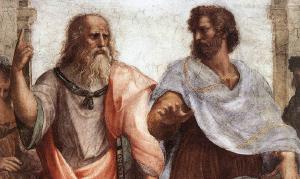Blog
Of Cabbages and Kings
19 May 2014
 Raffaello Sanzio da Urbino
Raffaello Sanzio da UrbinoWhen talking about scientific ideas, you often hear terms such as theories, hypotheses, facts, laws, models, etc. Some of these terms are used in everyday speech, but with meanings other than their scientific ones. Someone might say they have a theory, when they really mean they have an idea. People talk about scientific laws as if they are facts, or use the phrase “just a theory” to distinguish it from some idealized truth. Even scientists will sometimes interchange terms like theory and law. We know what we mean, but we aren’t always precise with our usage. So what do these terms mean in a scientific sense?
The big three in scientific nomenclature are law, hypothesis and theory.
A scientific law is an empirical relation that can be summarized in a concise way either verbally or mathematically. They are relations that are well validated by experiment, such as Newton’s Laws of Motion. In the strict sense, laws should be valid without exception. It is this sense that is often used when referring to the “laws of nature”. However because of their history there are many things we refer to as laws that we now know aren’t strictly valid. Kepler’s Laws of Planetary Motion, for example, aren’t strictly true because of the gravitational interactions between planets. Kepler’s Laws are merely a reasonable approximation, but we still refer to them as laws because of their history. Even worse, we have things like Bode’s Law for planetary distances, which isn’t a valid relation at all. The important things about laws, though, is that they are purely observational. A law doesn’t propose an underlying mechanism, it simply is an observed relation.
A hypothesis is an idea or proposed theory that can be tested either experimentally or observationally. The term generally doesn’t apply to basic ideas or rudimentary concepts, but rather to ideas that have been fleshed out a bit. The important thing about a hypothesis is that it must be capable of being falsified. This is why, for example, intelligent design is not a hypothesis. The premise of intelligent design is that there is an intelligence behind the evolutionary process, which is a tenet that cannot be falsified by scientific methods. As I’ve noted in an earlier post, it is possible to falsify a hypothesis based on observational evidence alone. Evolution, the big bang, and dark matter can all be falsified without some kind of repeatable experiment. (Though to be clear, evolution has been validated by repeatable experiments in the lab numerous times).
A theory is a comprehensive hypothesis or set of hypotheses that have been validated by confluence of evidence from a range of observational and/or experimental sources. Usually a theory refers to something so well validated by scientific evidence that it has become a foundational aspect of its field, such as the theory of evolution for biology, atomic theory for chemistry, and the big bang theory for astrophysics. A theory can never be proven true, so it is always possible that such a foundational theory may be found invalid, but it is very unlikely. It would also take a preponderance of incontrovertible evidence to overturn such a theory. This is something supporters of “fringe” ideas such as the electric universe don’t seem to understand. It isn’t enough for a new idea to explain an idea here and there, or to simply declare that an established theory is wrong or insufficient. A new hypothesis must be able to account for all the observational evidence of the old theory, and it must account for new evidence that invalidates the old theory. And it must do this to the same level and precision (if not better) than the theory it supplants. This has happened, for example when quantum theory supplanted Newtonian mechanics for things like atoms and molecules, and when general relativity supplanted it for larger objects.
One thing to keep in mind is that the amount of “truth” does not increase at each level. It is not the case that hypotheses become theories become laws. A hypothesis can become a theory, but more often multiple hypotheses are integrated into a general theory. Neither, however, become laws, since a law is merely an observed relation. Usually it is hypotheses and theories that are built up from laws, such as the Theory of gravity built upon the Newton’s laws of motion and law of gravity. In science, the theory is the thing, since it is deeply validated by the reality of scientific evidence.
There is some variation in usage within different scientific fields, and even individuals within a particular field. My own quirk is that I generally don’t refer to things as hypotheses. Since my field of physics and astrophysics tend to be highly mathematical, I generally refer to hypotheses as models. So Modified Newtonian Dynamics (MoND) is a model that has been largely (but not entirely) invalidated by observational evidence, while dark matter is a robust model that has been largely (though not entirely) validated by observational evidence. To me, the term model strikes a sweet point between common and scientific usage that both indicates that it is more than a mere idea, but also that it is open to being falsified.
With all of these terms, the goal is to pursue a deeper and broader understanding of the universe. So we discover laws, develop hypotheses, and test them until they either fail or are modified and integrated into better hypotheses. Always pushing to create deep, robust theories that represent our best understanding of cosmos.
And then we keep pushing.